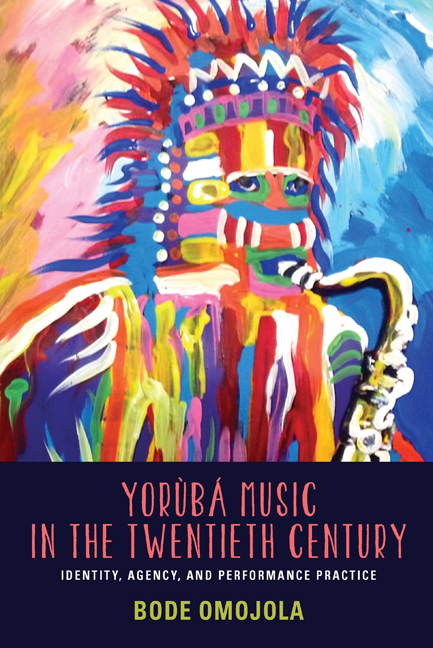Book contents
- Frontmatter
- Dedication
- Contents
- Acknowledgments
- Introduction
- 1 Yorùbá Drumming: Performance Practice and the Politics of Identity
- 2 Talking and Stammering: Toward an Analysis of Yorùbá Drumming
- 3 Songs of the King’s Wives: Gendered and Social Identities in Yorùbá Vocal Performance
- 4 The Aírégbé Song Tradition of Yorùbá Female Chiefs
- 5 Yorùbá Music in the Christian Liturgy: Notation, Performance, and Identity
- 6 Yorùbá Music in Christian Worship: The Aládǔrà Church
- 7 Yorùbá Popular Music: Hybridity, Identity, and Power
- 8 Yorùbá Islamic Popular Music
- Conclusion
- Appendixes
- Notes
- Selected Discography and Videography
- Bibliography
- Index
2 - Talking and Stammering: Toward an Analysis of Yorùbá Drumming
Published online by Cambridge University Press: 11 January 2024
- Frontmatter
- Dedication
- Contents
- Acknowledgments
- Introduction
- 1 Yorùbá Drumming: Performance Practice and the Politics of Identity
- 2 Talking and Stammering: Toward an Analysis of Yorùbá Drumming
- 3 Songs of the King’s Wives: Gendered and Social Identities in Yorùbá Vocal Performance
- 4 The Aírégbé Song Tradition of Yorùbá Female Chiefs
- 5 Yorùbá Music in the Christian Liturgy: Notation, Performance, and Identity
- 6 Yorùbá Music in Christian Worship: The Aládǔrà Church
- 7 Yorùbá Popular Music: Hybridity, Identity, and Power
- 8 Yorùbá Islamic Popular Music
- Conclusion
- Appendixes
- Notes
- Selected Discography and Videography
- Bibliography
- Index
Summary
The incursion of dùndún ensembles into sacred performance spaces originally exclusive to bàtá and other sacred drums, and the domination of modern, neotraditional performances by dùndún drummers both represent a significant development in twentieth-century Yorùbá music. This development is linked to dùndún's capability to imitate Yorùbá speech more accurately than its sister drum, bàtá, the so-called stammer drum, and, ultimately, to the significance of drum language in the conception, practice, and mediation of Yorùbá music. In analyzing selected examples of bàtá and dùndún drumming in this chapter, I explore the musical ramifications of speech surrogacy by drums, and demonstrate the link between performance practice and identity politics in Yorùbá drumming traditions. Although it is generally known that speech surrogacy is a vital aspect of West African drumming, its realization is far from being uniform across West Africa. David Locke, who has done extensive work on Ewe drumming in Ghana, has observed, for example, that among the Ewe, “usually, only drummers know the texts” that generate rhythmic patterns. He further explains that “even Ewe speakers cannot understand drum language just by hearing the music—they must be told.” In addition to the power of secrecy, “which makes restricted information valuable and powerful,” the relative lack of accessibility to the linguistic basis of Ewe drumming could also be due to the fact that Ewe drums, which are upright and without the tone-producing tendons of hourglass drums like the dùndún, lack the capability to clearly imitate the tonal inflections of speech found in hourglass drum traditions. John Miller Chernoff, discussing Dagomba drumming, also in Ghana, has noted that “for some dances like Zhem, the drum language is a secret, and drummers may be able to beat the drum without knowing the meaning.” He explains that Dagbamba drummers often “did not know the meaning” of their sounds, and had to travel “to Yendi to consult the chief drummer of the Paramount Chief of the Dagbon” to find out. The Yorùbá drumming tradition, however, contrasts sharply with these two Ghanaian examples in the sense that an effective mediation of the music is linked strongly to the disposition of performers and audiences to comprehend and interpret drum language in musical and linguistic terms.
- Type
- Chapter
- Information
- Yorùbá Music in the Twentieth CenturyIdentity, Agency, and Performance Practice, pp. 46 - 69Publisher: Boydell & BrewerPrint publication year: 2014



